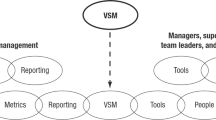Abstract
The implementation of a lean manufacturing strategy represents a robust contribution to the phase sequence that leads to operational excellence and the continuous improvement through the elimination of nonvalue-added activities. Therefore, lean practices contribute substantially to plant operational performance. This paper studies the use of value stream mapping (VSM) as a tool in lean manufacturing implementation and a framework of improvement activities, in particular for an efficient introduction of kanban and milkrun techniques. A case study illustrates VSM use, as well as kanban and milkrun systems application on an assembly line. Finally, the results obtained show the path of improvement, measured through the lean rate (LR) and dock-to-dock time (DtD).
Similar content being viewed by others
References
Womack JP, Jones DT, Roos D (1990) The machine that changed the world. Macmillan, New York
Cagliano R, Caniato F, Spina G (2004) Lean, agile and traditional supply: how do they impact manufacturing performance? J Purch Supply Manag 10(4–5):151–164 doi:10.1016/j.pursup.2004.11.001
Shah R, Ward P (2003) Lean manufacturing: context, practice bundles, and performance. J Oper Manag 21(2):129–149 doi:10.1016/S0272-6963(02)00108-0
Pavnaskar SJ, Gershenson JK, Jambekar AB (2003) Classification scheme for lean manufacturing tools. Int J Prod Res 41(13):3075–3090 doi:10.1080/0020754021000049817
Sullivan WG, McDonald TN, Van Aken EM (2002) Equipment replacement decisions and lean manufacturing. Robot Comput-Integr Manuf 18(3):255–265 doi:10.1016/S0736-5845(02)00016-9
Womack JP, Jones DT (1996) Lean thinking: banish waste and create wealth in your corporation. Simon & Schuster, New York
Abdulmalek FA, Rajgopal J (2007) Analyzing the benefits of lean manufacturing and value stream mapping via simulation: a process sector case study. Int J Prod Econ 107(1):223–236 doi:10.1016/j.ijpe.2006.09.009
Serrano I, Ochoa C, de Castro R (2008) Evaluation of value stream mapping in manufacturing system redesign. Int J Prod Res 46(16):4409–4430 doi:10.1080/00207540601182302
Sahoo AK, Singh NK, Shankar R, Tiwari MK (2008) Lean philosophy: implementation in a forging company. Int J Adv Manuf Technol 36(5–6):451–462 doi:10.1007/s00170-006-0870-2
Lai CL, Lee WB, Ip WH (2003) A study of system dynamics in just-in-time logistics. J Mater Process Technol 138(1):265–269 doi:10.1016/S0924-0136(03)00083-9
Chan FTS (2001) Effect of kanban size on just-in-time manufacturing systems. J Mater Process Technol 116(2):146–160 doi:10.1016/S0924-0136(01)01022-6
Lee-Mortimer A (2006) A lean route to manufacturing survival. Assem Autom 26(4):265–272 doi:10.1108/01445150610705155
Domingo R, Álvarez R, Peña MM, Calvo R (2007) Materials flow improvement in a lean assembly line: a case study. Assem Autom 27(2):141–147 doi:10.1108/01445150710733379
Álvarez R, Calvo R, Peña MM, Domingo R (2007) Improvement of parts flow of an assembly line applying lean tools. In: Proceedings of the 2nd Manufacturing Engineering Society International Conference (MESIC), Madrid
Browning TR, Heath RD (2008) Reconceptualizing the effects of lean on production costs with evidence from the F-22 program. J Oper Manag. doi:10.1016/j.jom.2008.03.009
Shah R, Ward PT (2007) Defining and developing measures of lean production. J Oper Manag 25(4):785–805 doi:10.1016/j.jom.2007.01.019
Kumar CS, Panneerselvam R (2007) Literature review of JIT-kanban system. Int J Adv Manuf Technol 32(3–4):393–408 doi:10.1007/s00170-005-0340-2
Srinivasaraghavan J, Allada V (2006) Application of mahalanobis distance as a lean assessment metric. Int J Adv Manuf Technol 29(11–12):1159–1168 doi:10.1007/s00170-005-0004-2
Holweg M (2007) The genealogy of lean production. J Oper Manag 25(2):420–437 doi:10.1016/j.jom.2006.04.001
Miltenburg J (2001) One-piece flow manufacturing on U-shaped production lines: a tutorial. IIE Trans 33(4):303–321
Calvo R, Domingo R, Sebastián MA (2007) Operational flexibility quantification in a make-to-order assembly system. Int J Flex Manuf Syst 19(3):247–263 doi:10.1007/s10696-008-9037-9
ElMaraghy HA (2005) Flexible and reconfigurable manufacturing systems paradigms. Int J Flex Manuf Syst 17(4):261–276 doi:10.1007/s10696-006-9028-7
Hopp WJ, Spearman ML (2004) To pull or not to pull: what is the question? Manuf Serv Oper Manag 6(2):133–148
Monden Y (1998) Toyota production system: an integrated approach to just-in-time, 3rd edn. Engineering and Management Press, Norcross, GA
Spearman ML, Woodruff DL, Hopp WJ (1990) CONWIP: a pull alternative to kanban. Int J Prod Res 28(5):879–894 doi:10.1080/00207549008942761
Yang KK (2000) Managing a flow line with single-kanban, dual-kanban or CONWIP. Prod Oper Manag 9(4):349–366
Ghamari YK (2006) Analyzing kanban and CONWIP controlled assembly systems. MSc Thesis, University of Tsukuba, Japan. Available at http://infoshako.sk.tsukuba.ac.jp/∼rsato/pdffiles/Yaghoub2006.pdf
Markham IS, Mathieu RG, Wray BA (1998) A rule induction approach for determining the number of kanbans in a just-in-time production system. Comput Ind Eng 34(4):717–727 doi:10.1016/S0360-8352(98)00099-0
Lian Y-H, Van Landeghem H (2007) Analysing the effects of Lean manufacturing using a value stream mapping-based simulation generator. Int J Prod Res 45(13):3037–3058 doi:10.1080/00207540600791590
Rother M, Shook J (1999) Learning to see: value stream mapping to add value and eliminate MUDA. The Lean Enterprise Institute, Brookline, MA
Author information
Authors and Affiliations
Corresponding author
Rights and permissions
About this article
Cite this article
Álvarez, R., Calvo, R., Peña, M.M. et al. Redesigning an assembly line through lean manufacturing tools. Int J Adv Manuf Technol 43, 949–958 (2009). https://doi.org/10.1007/s00170-008-1772-2
Received:
Accepted:
Published:
Issue Date:
DOI: https://doi.org/10.1007/s00170-008-1772-2




